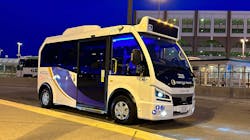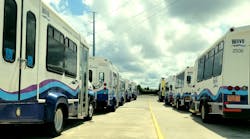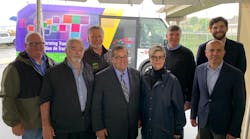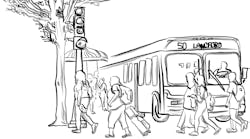What Kind of Big Impact Will a New Minibus Have on North America’s Small Bus Market?
Attendees at the American Public Transportation Association’s (APTA) Legislative Conference held in Washington, D.C., this past March, laid eyes on a relatively unfamiliar sight to North America: A 20-foot, low-entrance, electric minibus. This pint-sized vehicle style, while new to the North American market, carries loads of potential positive impacts. A new vehicle style could provide some level of relief to a small bus market hit hard by supply chain challenges. Its size lends itself to the nimbleness required of vehicles used for microtransit or on-demand services, and it’s electric, which supports the industry’s wider move toward lower and zero-emission fleets.
Upon a first glimpse, none of these things bubble to the top of the thought process. Like its automotive cousins, the Mini Cooper and Smart car, the initial description that jumps into one’s mind when seeing a low-entrance minibus is a single word: Cute.
“It is cute. We don’t promote it that way, but that seems to be the reaction,” said Roger D’Hollander, chief operating officer of Damera Bus Sales Canada Corp. “We have to go with that description because everybody who sees it says the same thing.”
The bus parked outside APTA’s show hotel was a 20-foot electric e-JEST manufactured by Turkish company Karsan Automotive and distributed exclusively in North America by Damera. The bus is part of the vehicle’s first U.S. demonstration project at Minnesota Valley Transportation Authority (MVTA), where its performance in winter conditions is being evaluated. According to MVTA Board records, the vehicle’s initial evaluation is positive.
D’Hollander explains the e-JEST is purpose built for transit use rather than other styles of minibuses that use a standard chassis with a modified body frame. A diesel version of the e-JEST has been available in the global market for more than a decade, and its electric version was released about four years ago. D’Hollander says the vehicle’s popularity has grown with more than 12,000 currently in service across Europe.
“I describe it as a 40-foot bus in a 20-foot footprint,” said D’Hollander. “In North America, customers have interest in using it for on demand or microtransit and, obviously, it's not going to replace mainline fixed routes, but it will be a great feeder for those fixed routes.”
Along with the growing interest in microtransit or on-demand service, the arrival of a new vehicle type to North America comes during a period where supply chain issues, particularly in the small bus market, have been adding to pandemic recovery pressures felt by transit agencies.
Small bus service providers have faced price increases and growing wait times in delivery of vehicles according to the Community Transportation Association of America (CTAA). A survey conducted by the association last fall found more than 80 percent of respondents classified their level of concern regarding vehicle replacements as very concerned or an unprecedented level of concern. Approximately 37 percent are expecting price increases exceeding 40 percent and the estimated backlog as of fall 2022 was 20,000 vehicles – a number that is expected to increase in 2023.
Inaugural service: Saint John Transit
Saint John Transit in Saint John, New Brunswick, was the first transit provider in North America to receive an e-JEST. A demonstration vehicle arrived in June 2022 and six leased vehicles were delivered in mid-December before being placed into service in January 2023 as part of a pilot project that also includes a 40-foot BYD electric bus. Saint John Transit is targeting 2040 to have its fleet completely transitioned over to zero-emission. Ian MacKinnon, director of transit and fleet services for Saint John, explains the move toward a zero-emission fleet is the result of a perfect storm of high diesel prices, a want to implement on-demand transit in low ridership areas and the availability of federal funding.
“We're very specific about growth activities in this city. We recognize the relationship between transit and growth, transit and parking, transit and car traffic and we want to encourage the use of transit,” MacKinnon said. “We were thinking of how to better provide transit services to low frequency, low ridership areas, which led us to on-demand and, if we’re going in that direction, let’s make the whole thing green.”
MacKinnon explains its intuitive to believe the move toward zero-emission vehicles will deliver operational efficiencies, but Saint John Transit wants to prove those efficiencies. It has partnered with a telematics company to collect data on the six e-JEST buses and 40-foot bus to track everything from battery life and maintenance costs to how the bus was driven. After a year of data collection, the information will then be compared to data from diesel buses operating on the same routes.
“We want to prove its cost effective and, once we do, we're all in,” said MacKinnon.
MacKinnon says adjustments were needed to the e-JEST vehicles, as is the case with any new vehicle, to account for nuances of the bus being designed outside of the U.S. or Canada. For example, the minibus operator seat was not aligned with the console, which was corrected during the first few weeks after delivery. Operators and mechanics were trained in how to operate, maintain and comply with new safety standards associated with the smaller, electric vehicles. The transit agency also went through a learning curve with its charge management.
Saint John is on a hill and located on a bay with frequent freeze/thaw cycles during the winter. MacKinnon says the agency learned a lot during the first three months from a route planning perspective and charging perspective.
The pilot service has been well received by passengers who are using the stop-to-stop service to access transit connection points with higher frequency.
“All the feedback has been fantastic. I haven't heard anything other than positive feedback from our user base,” said MacKinnon.
Taking a wider lens on the industry, MacKinnon explains smaller buses, like the e-JEST, have an application in serving fringe areas with low ridership.
“In all transit - small, mid-size, large - they have a fringe location of low ridership and smaller buses have an application, as does on-demand service. Historically, transit addressed those low ridership areas with 40-foot diesel buses, and I think I think those days are changing,” said MacKinnon.
Buy America compliance
The wider adoption of the e-Jest in the U.S. will depend on its ability to comply with or attain a waiver for the Build America, Buy America Act, which outlines what components should be made in the U.S. and where assembly of goods should occur.
D’Hollander says Damera is working with the Federal Transit Administration, Damera’s transit partners and other stakeholders to develop and implement a phased approach that will support the spirit of the Buy America policy. He notes the company is working and managing the waiver process while it progresses through its plan, which starts with establishing a parts facility in Iowa, followed by second parts facility in California.
D’Hollander explains the company will reach 30 percent America content of the buses by ensuring several of the vehicle’s peripheral components, including lighting, the ADA ramp, mirrors and seating, are made in the U.S. The percentage will increase to 60 percent with the addition of batteries from Michigan-manufacturer ONE, which should begin by the end of 2023. The final phase will be manufacturing and assembly of the bus at a U.S. facility, the location of which is still being finalized.
“By the middle of 2024, we will definitely have a manufacturing facility in operation and the majority of the buses that are being delivered in the U.S. will be coming from that facility,” said D’Hollander.
Winning hearts and minds: Oakville Transit
Oakville, Ontario, sits on the edge of Lake Ontario slightly more than 20 miles southwest of Toronto. Oakville Transit is part of a larger regional area and as Adrian Kawun, director, Oakville Transit, explains, the town takes great pride in providing superior service and innovative solutions.
Oakville Transit has taken delivery of 15 e-JEST buses and is in the process of commissioning them before they are placed into specialized and on-demand service, which is planned for the end of May. The minibuses support Oakville Transit’s incremental transition to a zero-emission fleet.
“The idea here is that before you can go and buy a full suite of electric vehicles, you really have to understand, from an operator perspective, how you are going to actually recharge these vehicles,” Kawun said. “We did an electric infrastructure review of our facility and identified that we could accommodate these 15 electric buses without any change to our existing operation in terms of the electricity.”
While modifications were not needed, operators and mechanics did undergo training to ensure the safe operation of the new additions to the fleet.
“These vehicles drive more like a car; they’re nimble and easy to get around, but that being said, they’re electric and there’s a lot of torque to them,” Kawun explained. “An operator will have an impact on how far these vehicles go. When we trained the operators, we focused on how to maintain that electric charge and battery to provide more distance.”
Kawun reports feedback has been overwhelmingly positive from both operators and customers, who have been introduced to the vehicles during charters and at special events. He said an unusual reaction observed from riders is people tend to be quieter in the e-JEST because it’s a smaller bus and doesn’t make the same level of noise a diesel bus would.
“The operators love these things. They’re comfortable, and they can’t believe the amount of power the vehicles hold, the distances they can go,” said Kawun. “We have operators who don't usually operate the specialized or on-demand service that want to because they want to get into these vehicles.”
When Kawun ponders the greater impact of the e-JEST’s potential impact on the North American transit industry, he explains the more options available to operate in terms of vehicles, the more options that can be provided to the customer.
“These vehicles will change the way agencies in areas like mine provide our service or add to our service delivery in terms of reorganizing how we operate within the town,” said Kawun. “These vehicles are 100 percent accessible, which then gives us the opportunity to provide transit services as a transit service and not a two-tier system where we have a conventional system and then a specialized system. Now, it's the transit bus. There's no stigma attached to it. It is for everybody, anytime, anywhere.”

Mischa Wanek-Libman | Group Editorial Director
Mischa Wanek-Libman is director of communications with Transdev North America. She has more than 20 years of experience working in the transportation industry covering construction projects, engineering challenges, transit and rail operations and best practices.
Wanek-Libman has held top editorial positions at freight rail and public transportation business-to-business publications including as editor-in-chief and editorial director of Mass Transit from 2018-2024. She has been recognized for editorial excellence through her individual work, as well as for collaborative content.
She is an active member of the American Public Transportation Association's Marketing and Communications Committee and served 14 years as a Board Observer on the National Railroad Construction and Maintenance Association (NRC) Board of Directors.
She is a graduate of Drake University in Des Moines, Iowa, where she earned a Bachelor of Arts degree in Journalism and Mass Communication.





